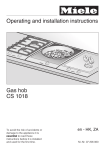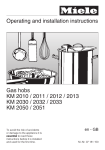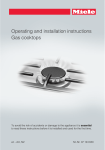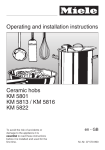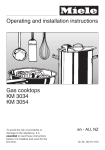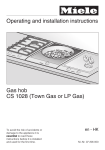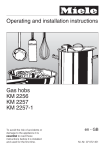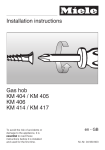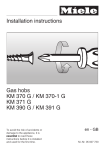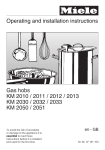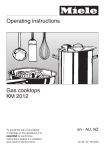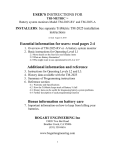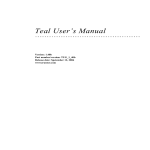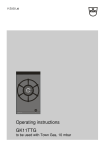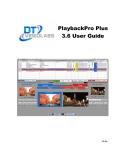Download Miele CS 1012-1 Technical data
Transcript
Operating and installation instructions Gas hob CS 1013-1 To avoid the risk of accidents or damage to the appliance it is essential to read these instructions before it is installed and used for the first time. en - HK, ZA M.-Nr. 09 029 800 G This appliance can be used in countries other than those specified on the appliance. It is, however, set up for connection to the gas and electricity supplies in the countries specified. For use in other countries please contact the Miele spare parts or customer service department in your country. D Das Gerät ist auch für den Gebrauch in anderen als auf dem Gerät angegebenen Bestimmungsländer zugelassen. Die landesspezifische Ausführung und die Anschlussart des Gerätes haben wesentlichen Einfluss auf den einwandfreien und sicheren Betrieb. Für den Betrieb in einem anderen als auf dem Gerät angegebenen Bestimmungsland wenden Sie sich bitte an den für das Land zuständigen Kundendienst. E El aparato está autorizado para el uso en países diferentes a los países de destino indicados. La ejecución específica para cada país y el tipo de conexión del aparato influyen de forma decisiva en el funcionamiento correcto y seguro. Para el funcionamiento en un país diferente al país de destino indicado en el aparato, consulte al Servicio Post-venta autorizado para el país. F Cet appareil est également homologué dans des pays différents de ceux mentionnés sur l'appareil. Pour que l'appareil fonctionne parfaitement et en toute sécurité, il est important de disposer de l'exécution spécifique au pays et du type de raccordement approprié. Pour le fonctionnement dans un pays autre que celui spécifié sur l'appareil, veuillez vous adresser au service après-vente du pays où sera installé l'appareil. I L'apparecchio può essere usato anche in paesi diversi da quello indicato sull'apparecchio stesso. Tuttavia, le varianti specifiche di un determinato paese e il tipo di allacciamento alla rete hanno un'importanza fondamentale per il suo sicuro e corretto funzionamento. Per questo se si vuole usare l'apparecchio in un paese diverso rivolgersi al servizio di assistenza tecnica Miele del paese in cui si intende usarlo. M Het apparaat is ook toegelaten voor gebruik in andere landen dan de landen die op het apparaat vermeld staan. De specifieke uitvoering en de aansluitwijze zijn van groot belang voor het goed en veilig functioneren. Neem daarom contact op met de Technische Dienst van de fabrikant in uw land als u het apparaat in een land wilt gebruiken dat niet op het apparaat vermeld staat. 2 Gas-heated appliances Safety precautions to take if you smell gas ß Turn off the gas emergency control valve immediately. This is usually located near the gas meter. ß Eliminate all sources of ignition in a safe manner. Do not smoke, light cigarette lighters or matches. ß Do not operate electrical lights or switches, i.e. do not switch them "On" or "Off". ß Open all doors and windows to ventilate the area. ß If the smell of gas persists, evacuate the building. 3 Inhalt Guide to the appliance . . . . . . . . . . . . . . . . . . . . . . . . . . . . . . . . . . . . . . . . . . . . . 5 Warning and Safety instructions . . . . . . . . . . . . . . . . . . . . . . . . . . . . . . . . . . . . . 7 Caring for the environment . . . . . . . . . . . . . . . . . . . . . . . . . . . . . . . . . . . . . . . . . 13 Before using for the first time. . . . . . . . . . . . . . . . . . . . . . . . . . . . . . . . . . . . . . . 14 Operation . . . . . . . . . . . . . . . . . . . . . . . . . . . . . . . . . . . . . . . . . . . . . . . . . . . . . . . 15 Switching on, adjusting the flame and switching off . . . . . . . . . . . . . . . . . . . . . . . 15 Pans . . . . . . . . . . . . . . . . . . . . . . . . . . . . . . . . . . . . . . . . . . . . . . . . . . . . . . . . . . . 17 Safety . . . . . . . . . . . . . . . . . . . . . . . . . . . . . . . . . . . . . . . . . . . . . . . . . . . . . . . . . . 18 Cleaning and care . . . . . . . . . . . . . . . . . . . . . . . . . . . . . . . . . . . . . . . . . . . . . . . . 19 General notes . . . . . . . . . . . . . . . . . . . . . . . . . . . . . . . . . . . . . . . . . . . . . . . . . . . . 19 Stainless steel surfaces . . . . . . . . . . . . . . . . . . . . . . . . . . . . . . . . . . . . . . . . . . . . . 20 Pan supports, control knobs . . . . . . . . . . . . . . . . . . . . . . . . . . . . . . . . . . . . . . . . . 20 Burner . . . . . . . . . . . . . . . . . . . . . . . . . . . . . . . . . . . . . . . . . . . . . . . . . . . . . . . . . . 21 Problem solving guide . . . . . . . . . . . . . . . . . . . . . . . . . . . . . . . . . . . . . . . . . . . . 22 Optional accessories . . . . . . . . . . . . . . . . . . . . . . . . . . . . . . . . . . . . . . . . . . . . . . 23 Safety instructions for installation . . . . . . . . . . . . . . . . . . . . . . . . . . . . . . . . . . . 24 Appliance and building-in dimensions . . . . . . . . . . . . . . . . . . . . . . . . . . . . . . . 28 Preparing the worktop . . . . . . . . . . . . . . . . . . . . . . . . . . . . . . . . . . . . . . . . . . . . . 29 Installation of several appliances. . . . . . . . . . . . . . . . . . . . . . . . . . . . . . . . . . . . 30 Fixing the spring clamps and spacer bars . . . . . . . . . . . . . . . . . . . . . . . . . . . . 33 Installing / removing the appliance . . . . . . . . . . . . . . . . . . . . . . . . . . . . . . . . . . 35 General installation tips . . . . . . . . . . . . . . . . . . . . . . . . . . . . . . . . . . . . . . . . . . . 36 Electrical connection . . . . . . . . . . . . . . . . . . . . . . . . . . . . . . . . . . . . . . . . . . . . . . 37 Gas connection . . . . . . . . . . . . . . . . . . . . . . . . . . . . . . . . . . . . . . . . . . . . . . . . . . 39 LPG Gas Connection for HK . . . . . . . . . . . . . . . . . . . . . . . . . . . . . . . . . . . . . . . . . 40 LPG Gas Connection for SG . . . . . . . . . . . . . . . . . . . . . . . . . . . . . . . . . . . . . . . . . 40 Conversion to another type of gas. . . . . . . . . . . . . . . . . . . . . . . . . . . . . . . . . . . 43 Jet table . . . . . . . . . . . . . . . . . . . . . . . . . . . . . . . . . . . . . . . . . . . . . . . . . . . . . . 43 Changing the jets. . . . . . . . . . . . . . . . . . . . . . . . . . . . . . . . . . . . . . . . . . . . . . . . . . 44 After changing the jets. . . . . . . . . . . . . . . . . . . . . . . . . . . . . . . . . . . . . . . . . . . . . . 45 After sales service, data plate . . . . . . . . . . . . . . . . . . . . . . . . . . . . . . . . . . . . . . 46 Technical Data . . . . . . . . . . . . . . . . . . . . . . . . . . . . . . . . . . . . . . . . . . . . . . . . . . . 47 4 Guide to the appliance Front view a Large burner b Normal burner c Pan support d Symbols to indicate which gas burner the control is for Controls: e rear f front 5 Guide to the appliance Burner n Burner cap o Burner head p Ignitor q Ignition safety device r Burner base 6 Warning and Safety instructions Correct application This appliance complies with all current local and national safety requirements. Improper use can, however, present a risk of both personal injury and material damage. ~ This hob is not designed for commercial use. It is intended for use in domestic households and in similar working and residential environments such as: – Shops To avoid the risk of accidents and damage to the appliance, please read these instructions carefully before installation and before using it for the first time. They contain important notes on installation, safety, use and maintenance. Keep these instructions in a safe place and ensure that new users are familiar with the content. Pass them on to any future owner. – Offices and showrooms and by residents in establishments such as: – Hostels and guest houses. ~ The hob is intended for domestic use only to cook food and keep it warm. Any other use is not supported by the manufacturer and could be dangerous. Miele cannot be held liable for damage resulting from incorrect or improper use or operation. ~ The hob is not intended for outdoor use. ~ The hob can only be used by people with reduced physical, sensory or mental capabilities or lack of experience and knowledge if they are supervised whilst using it, or have been shown how to use it in a safe way and understand the hazards involved. 7 Warning and Safety instructions Safety with children ~ The hob is not a toy! To prevent the risk of injury, do not let children play with the appliance or its controls. ~ Children under 8 years of age must be kept away from the hob unless they are constantly supervised. ~ Children 8 years and older may use the hob only if they have been shown how to use it in a safe way and understand the hazards involved. ~ The hob gets hot when in use and remains hot for quite a while after being switched off. Keep children well away from the appliance until it has cooled down and there is no danger of burning. ~ Do not store anything which might arouse a child's interest in storage areas above or next to the hob. Otherwise they could be tempted into climbing onto the appliance with the risk of burning themselves. ~ Keep all pans out of reach of children. Turn pan handles inwards away from the edge of the hob. Danger of burning or scalding. ~ Packaging, e.g. cling film, polystyrene and plastic wrappings, must be kept out of the reach of babies and young children. Danger of suffocation. Dispose of or recycle all packaging safely as soon as possible. 8 Warning and Safety instructions Technical safety ~ Before installation, check the hob for visible signs of damage. Do not install and use a damaged appliance. It could be dangerous. ~ The electrical safety of the hob can only be guaranteed if correctly earthed. It is most important that this basic safety requirement is observed and regularly tested, and where there is any doubt, the household wiring system should be inspected by a qualified electrician. Miele cannot be held liable for the consequences of an inadequate earthing system (e.g. electric shock). ~ The connection to the gas supply should only be undertaken by an registered gas installer under the gas safety regulations (Registration of Gas Installers and Gas Contractors). If the appliance is supplied without a plug, or if the plug is removed, it must be connected to the mains electricity supply by a suitably qualified and competent electrician in strict accordance with current local and national safety regulations. The manufacturer cannot be held liable for damage caused by incorrect installation or connection. ~ Installation, maintenance and ~ Before connecting the hob to the mains electricity supply, make sure that the data quoted on the data plate match the household mains supply, otherwise the appliance could be damaged. Consult a qualified electrician if in any doubt. repairs may only be carried out by a suitably qualified and competent person in strict accordance with current national and local safety regulations. Repairs and other work by unqualified persons could be dangerous. The manufacturer cannot be held liable for unauthorised work. ~ For safety reasons, the hob may only be used after it has been built in. ~ During installation, maintenance and ~ Do not open the casing of the hob. Tampering with electrical connections or components and mechanical parts is highly dangerous to the user and can cause operational faults. ~ While the hob is under guarantee, repair work, the hob must be disconnected from the gas supply and mains electricity supply. repairs should only be undertaken by a service technician authorised by Miele. Otherwise the guarantee is invalidated. 9 Warning and Safety instructions ~ Faulty components must only be replaced by genuine Miele original spare parts. The manufacturer can only guarantee the safety of the appliance when Miele replacement parts are used. ~ If the connection cable is damaged, it must be replaced by a suitably qualified electrician with a special connection cable of type H 05 V V-F (pvc insulated), available from Miele. ~ The hob is not intended for use with an external timer switch or a remote control system. ~ Do not connect the hob to the mains electricity supply by a multi-socket adapter or an extension lead. These do not guarantee the required safety of the appliance (e.g. danger of overheating). ~ Do not use the hob if it is faulty. Switch it off immediately and disconnect it from the mains electricity supply and the gas supply. Call the Service Department. Correct use ~ Do not leave the hob unattended whilst it is being used. Oil and fat are potential fire hazards as they can ignite if overheated. ~ If oil or fat does catch fire, do not attempt to put out the flames with water. Use a suitable fire blanket, saucepan lid, damp towel or similar to smother the flames. ~ Do not use the hob to heat up the room. Due to the high temperatures radiated, objects near the appliance could catch fire. The life of the appliance could also be reduced. ~ Use heat-resistant pot holders or gloves when using the hob. Ensure that they do not come into contact with the flames. Do not use large cloths, tea towels or similar as the ends could touch the flames and catch fire. Do not let the gloves get damp or wet, as this causes heat to transfer through the material more quickly with the risk of scalding or burning yourself. ~ Do not flambé under a cooker hood. The flames could set the cooker hood on fire. ~ The hob gets hot when in use and remains hot for quite a while after being switched off. Do not touch it whilst it could still be hot. ~ Do not use the hob as a resting ~ If a cooker hood is installed above the hob, ensure that the burners are always covered with a pan when in use. Otherwise flames could reach the cooker hood, parts of which could then be damaged or set on fire. ~ Where several appliances are 10 place for anything. When the appliance is switched on either deliberately or by mistake, or when there is residual heat present, the article could melt or catch fire. installed side by side Do not place hot pots or pans on the cover strip as this can damage the seal. Warning and Safety instructions ~ Do not cover the hob, e. g. with a hob cover, a cloth or protective foil. The material could catch fire, shatter or melt if the appliance is switched on by mistake or if it is still warm. ~ Do not store any inflammable ~ Do not use plastic or aluminium foil containers. These melt at high temperatures and could catch fire. ~ Replace the pan supports carefully ~ Do not heat up unopened tins of food on the hob, as pressure will build up in the tin, causing it to explode. This could result in injury and scalding or damage. ~ Using the hob will cause a build-up ~ Make sure all the components of the gas burners have been correctly assembled before switching on. ~ Pans must be the correct size for the burner they are used on (see "Suitable pans"). A pan which is too small will be unstable on the pan support. If the pan diameter is too large, flames can spread out to the sides and damage or burn the worktop, wall claddings or surrounding units and also parts of the hob. Miele cannot be held liable for this type of damage. ~ Ensure that the flames from the burner do not spread out beyond the base and up the sides of the pan. ~ Unless the pan manufacturer states that you can do so, do not use pans with very thin bases on the hob, and never heat up empty pans as they could get damaged. This could also damage the appliance. objects near the hob. ~ Remove splashes of fat and other food debris from the surface as soon as possible. These are a fire hazard. to avoid scratching the surface of the hob. of heat and moisture in the room in which it is installed. Ensure that the room has sufficient natural or mechanical means of ventilation, e.g. an extractor. ~ If the hob is used for very long periods of time additional ventilation of the room may be necessary, e.g. by opening windows or doors, or running the extractor on the highest setting. ~ When using an electrical appliance, e.g. a hand-held food blender, near the hob, ensure that the cable of the electrical appliance does not come into contact with the hot hob. The insulation on the cable could become damaged, giving rise to an electric shock hazard. ~ Spray canisters, aerosols and other inflammable substances must not be stored in a drawer under the hob. Cutlery inserts must be heat-resistant. ~ The pan support supplied must always be used. Pans must not be placed directly on the burner. 11 Warning and Safety instructions ~ Always ensure that food is sufficiently cooked or reheated. Some foods may contain micro-organisms which are only destroyed by thorough cooking at a sufficiently high temperature for long enough. Therefore, when cooking or reheating food such as poultry, it is particularly important that the food is completely cooked through. If in doubt, select a longer cooking or reheating time. ~ Avoid allowing liquids or foods containing salt to spill onto the hob. If salty foods or liquids do get on the hob, they should be removed as soon as possible to avoid the risk of corrosion. ~ If the hob is installed behind a kitchen furniture door, it may only be used with the furniture door open. Only close the door when the appliance is switched off and the residual heat indicators have gone out. ~ If the hob has not been used for a long period of time it should be thoroughly cleaned before it is used again. It is also advisable to have the appliance tested for safety. Miele cannot be held liable for damage caused by non-compliance with these Warning and Safety instructions. 12 Caring for the environment Disposal of the packing material The transport and protective packing has been selected from materials which are environmentally friendly for disposal, and should be recycled. Ensure that any plastic wrappings, bags, etc. are disposed of safely and kept out of the reach of babies and young children. Danger of suffocation. Disposal of your old appliance Electrical and electronic appliances often contain materials which, if handled or disposed of incorrectly could be potentially hazardous to human health and to the environment. They are, however, essential for the correct functioning of your appliance. Please do not therefore dispose of it with your household waste. Please dispose of it at your local community waste collection/recycling centre or contact your dealer for advice. Ensure that it presents no danger to children while being stored for disposal. 13 Before using for the first time Please stick the extra data plate for the appliance supplied with this documentation in the space provided in the "After sales service" section of this booklet. Cleaning for the first time ^ Remove any protective foil and stickers. ^ Clean all removable parts of the burners with a solution of warm water and a little washing-up liquid applied with a soft sponge. Dry all parts thoroughly after cleaning and then reassemble the burners (see "Cleaning and care"). ^ Clean the stainless steel trough with a damp cloth, and then wipe dry. Metal components have a protective coating which may give off a slight smell when heated up for the first time. The smell and any vapours will dissipate after a short time, and do not indicate a faulty connection or appliance. 14 Operation Switching on, adjusting the flame and switching off The control knob is used to ignite the burner and regulate the strength of the flame. ßThe gas supply is turned off & strong flame / weak flame The burners can only be switched on by pressing in the appropriate control and turning it anti-clockwise, and switched off by turning the control clockwise. The following will cause damage to the appliance: - Switching on the burner without pressing the control down, - Switching the burner on by turning the control clockwise, - Switching the burner off by turning the control anti-clockwise. The manufacturer will not accept liability for any damaging resulting from incorrect operation. 15 Operation Switching on ^ Keep the control pressed in for a further 8-10 seconds and then release it. Regulating the flame ^ The control for the burner required must be pressed in and turned anti-clockwise to the large flame symbol to switch on. ^ When the flame ignites, keep the control pressed in for 8-10 seconds, and then let it go. Do not press the control knob for more than 15 seconds. If the burner does not ignite within these 15 seconds, release the control knob and open the door or wait for at least 1 minute before making a new ignition attempt. In the event of the burner flames being accidentally extinguished, turn off the burner control and do not attempt to re-ignite the burner for at least 1 min. In the event of a power cut If there is an interruption to the electricity supply the gas can be ignited with a match: ^ Press in the relevant control and turn it anti-clockwise to the large gas symbol. ^ Hold the control pressed in and light the gas at the burner with a match. 16 The burners can be regulated at any level between the strongest and weakest flame. Control the flame so that it does not spread out beyond the sides of the pan. As the outer part of the flame is much hotter than the centre, the tips of the flames should stay beneath the pan base. Flame tips which extend beyond the sides of the pan merely warm up the air in the room and can also damage pan handles and increase the risk of injury. Switching off ^ Turn the control clockwise to position "ß" . This stops the flow of gas and the flame goes out. Pans Burner Min. pan base diameter in cm Normal burner 12 Large burner 14 Max. diameter at top of pan in cm Normal burner 22 Large burner 24 – Select pans which are suitable for the burner they are to be used on. In general: use larger diameter pans on the large burners, and smaller diameter pans on the small burners. – Refer to the chart above and ensure that the pan diameter falls within the minimum and maximum diameters given for the burner you are using. A pan which is too small will be unstable on the pan support. If the pan diameter is too large, flames can spread out to the sides and damage or burn the worktop, wall claddings or surrounding units and also parts of the hob. The manufacturer cannot be held liable for this type of damage. – Use a lid whenever possible to minimise heat loss. – Wide, shallow pans are preferable to tall, narrow ones. They will heat up faster. – Pans with thick bases are preferable as these distribute heat more evenly. With thin bases, there is a danger of food overheating in places. Stir the food frequently. – Any heat-resistant pans can be used on a gas burner. – Remember when purchasing new pans that manufacturers usually refer to the diameter at the top of the pan in their documentation. 17 Safety Thermo-electric ignition This appliance has a thermo-electric ignition safety device. If the flame goes out, for example if food has boiled over or if there is a sudden draught, the supply of gas to the burner will be cut off. ^ To use the burner again, turn the control clockwise to the "ß" position, and then switch it back on as normal. The safety cut-out operates independently from the electricity supply. This means that it will still work if the hob is used during a power cut. 18 Cleaning and care General notes ,Under no circumstances use a steam cleaning appliance to clean this appliance . The steam could attack the electrical components and cause a short circuit. Pressurised steam could also cause permanent damage to the surface and to other components, for which the manufacturer cannot accept liability. The appliance should be cleaned after each use. Let it cool down to room temperature. To avoid water marks and limescale deposits use a soft cloth to dry surfaces that have been cleaned with water. Thoroughly remove salty food residues or liquids from the hob as soon as possible to avoid the risk of corrosion. To avoid damaging the surface or your hob, do not use: – cleaning agents containing soda, alkalines, ammonia, acids or chlorides, – cleaning agents containing descaling agents, – stain or rust removers, – abrasive cleaning agents, e.g. powder cleaners and cream cleaners, – solvent-based cleaning agents, – dishwasher cleaner, – grill and oven cleaners, – glass cleaning agents, – hard, abrasive brushes or sponges, e.g. pot scourers, brushes or sponges which have been previously used with abrasive cleaning agents, – sharp pointed objects (these can damage the seal between the frame and the worktop) 19 Cleaning and care Stainless steel surfaces Pan supports, control knobs Clean stainless steel surfaces with a solution of warm water and a little washing-up liquid applied with a soft sponge. In the case of stubborn dried-on soiling, soak first. Finally, dry with a soft cloth. Remove the pan supports. Clean the pan supports and the control knobs with a solution of warm water and a little washing-up liquid applied with a soft sponge. Stubborn soiling should be soaked first. If necessary a cleaning agent for ceramic and stainless steel surfaces can be used (see "Optional accessories"). Apply with even pressure following the direction of the "grain". After cleaning dry all surfaces with a clean cloth. Do not use stainless steel cleaning agents on printed surfaces. This would rub off the print. These areas should be only cleaned with a solution of warm water and a little washing-up liquid applied with a soft sponge. A conditioning agent for stainless steel can be used after cleaning to help keep your appliance looking good (see "Optional accessories"). Apply sparingly with a soft cloth following the instructions on the packaging. 20 Do not clean the pan supports in a dishwasher. Cleaning and care Burner Reassemble the burner Do not clean any parts of the burner in a dishwasher. The burner should be dismantled and then cleaned by hand using a solution of warm water and a little washing-up liquid applied with a soft sponge. Parts of the burner that cannot be removed should be wiped clean with a damp cloth only. The ignitor and ignition safety device should be very carefully wiped clean using a well wrung out cloth. Do not let the ignitor get wet. If it gets wet it will not spark. After cleaning dry all surfaces with a clean cloth. Make sure that the flame slits are clean and completely dry. The surfaces of the two burner caps will become more matt with time. This is quite normal and will not affect the operation of the hob. After cleaning the burner it must be reassembled in the correct order. ^ Place the burner head o on to the burner base r so that the the ignitor p and the ignition safety device q extend through their respective holes in the burner head. The burner head must click into place correctly. ^ Place burner cap n flat over burner head o. When correctly positioned it will not slide about. 21 Problem solving guide ,Repairs to the gas and electrical components of this appliance must only be carried out by a suitably qualified and competent person to ensure safety. Repairs and other work by unqualified persons could be dangerous. The manufacturer cannot be held liable for unauthorised work. What to do if... ... the burner does not ignite after several attempts. Check whether – the burner is correctly assembled. – the gas supply tap is turned on. – the burner is dry and clean. – the flame slits are dry and unblocked. ... the gas flame goes out after being lit. During the ignition process, the flames need to touch the ignition safety device so that it heats up. If the flames do not touch the ignition safety device, check that – the burner cover is correctly in position. – there is no soiling on the ignition safety device. If there is, remove it carefully (see "Cleaning and care"). 22 .... the ignitor on the burner does not spark. Check whether – the mains fuse has blown. If it has, contact a qualified electrician or the Miele Customer Contact Centre. – food deposits have lodged themselves between the ignitor and the burner cap, or on the ignition safety device. Remove any food deposits carefully (see "Cleaning and care"). – food has adhered to the ignition safety device. Remove any food deposits carefully (see "Cleaning and care"). ... the flame suddenly looks different. Check that the burner is correctly assembled. Optional accessories Miele offer a comprehensive range of useful accessories as well as cleaning and conditioning products for your Miele appliances. These can be ordered online at: or from Miele (see back cover for contact details) Ceramic and stainless steel hob cleaner 250 ml Removes heavy soiling, limescale deposits and light discolouration Stainless steel conditioning agent 250 ml Removes water marks, flecks and finger prints. Helps keep the hob looking good for longer. 23 Safety instructions for installation This appliance must be installed and connected to services in accordance with local and national safety and building regulations. To avoid the risk of damaging the hob fit the wall units and extractor hood before installing it. ~ The room in which the gas hob is installed must be at least 20 m3 in size with a door or window in it which can be opened to the outside air. ~ The veneer or laminate coatings of worktops (or adjacent kitchen units) must be treated with 100 °C heat-resistant adhesive which will not dissolve or distort. Any backmoulds must be of heat-resistant material. ~ This appliance must not be used in a non-stationary location (e.g. on a ship). ~ An electric fryer must not be installed directly next to a gas hob, as the gas flames could ignite the fat in the fryer. It is essential to maintain a distance of at least 288 mm between these two appliances. ~ A gas hob may not be built in over a fridge, fridge freezer, freezer, dishwasher, washing machine or tumble dryer. ~ The hob may only be installed above a Miele oven if the worktop is at least 40 mm thick. 24 ~ Ensure that the gas pipe and electrical cable are installed in such a way that they do not touch any parts of the appliance which become hot. This could cause damage. ~ The electrical cable and any flexible gas connection pipes must be installed in such a way so that they do not come into contact with any moving kitchen parts (e.g. a drawer), and cannot become trapped. ~ Observe carefully the safety distances given on the following pages. All dimensions in this instruction booklet are given in mm. Safety instructions for installation Safety distance above the appliance Safety Distance below the Hob There should be at least 30 mm height or plenty of space reserved at the bottom of the gas hob for the installation of the flexible gas connection pipe and electrical cable. It also avoids any possible hindrance towards the movement of all moveable kitchen parts (e.g. drawer). A minimum safety distance must be maintained between the appliance and the cooker hood above it. See the cooker hood manufacturer's operating and installation instructions for details. If the manufacturer's instructions are not available for the cooker hood, a minimum safety distance of at least 760 mm must be maintained. For any flammable objects, e.g. utensil rails, wall units etc. a minimum distance of at least 760 mm must be maintained between them and the appliance below. When two or more appliances are installed together below a cooker hood, e.g. an electric hob and a gas wok combiset, which have different safety distances given in their installation instructions you should select the greater distance of the two. 25 Safety instructions for installation Safety distances to the sides of the hob Ideally the hob should be installed with plenty of space on either side. There may be a wall at the rear and a tall unit or wall at one side. On the other side, however, no unit or divider should stand higher than the hob (see illustrations). Due to the high temperatures radiated by the hob, it is essential that a minimum distance of 50 mm is maintained between the worktop cut-out and the back wall. recommended The minimum distance a between the worktop cut-out and a wall or tall unit to the right or left of it is: 40 mm for CS 1212 / CS 1212-1 CS 1221 CS 1234 / CS 1234-1 CS 1223 50 mm for CS 1112 CS 1122 CS 1134 CS 1326 / CS 1327 CS 1411 100 mm for CS 1012 / CS 1012-1 CS 1013 / CS 1013-1 150 mm for CS 1421 CS 1312 CS 1322 200 mm for CS 1034 / CS 1034-1 250 mm for CS 1011 CS 1018 CS 1021 CS 1028 26 not recommended not allowed Safety instructions for installation Safety distance when installing the appliance near a wall with additional niche cladding A minimum safety distance must be maintained between the worktop cut-out and any niche cladding to protect it from heat damage. If the niche cladding is made from a combustible material (e. g. wood) a minimum safety distance e of 50 mm must be maintained between the cut-out and the cladding. If the niche cladding is made from a non-combustible material (e. g. metal, natural stone, ceramic tiles) a minimum safety distance e of 50 mm less the thickness of the cladding must be maintained between the cut-out and the cladding. Example: 15 mm niche cladding 50 mm - 15 mm = minimum safety distance of 35 mm a Masonry b Niche cladding Dimension x = thickness of niche cladding material c Worktop d Worktop cut-out e Minimum safety distance for combustible materials is 50 mm for non-combustible materials is 50 mm less dimension x 27 Appliance and building-in dimensions CS 1013-1 a Spring clamps b Front c Building-in depth d Mains connection box with mains connection cable, L = 1440 mm e Gas connection R 1/2 - ISO 7-1 (DIN EN 10226) 28 Preparing the worktop ^ Make the worktop cut-out for one or more appliances as applicable. Remember to maintain a minimum safety distance from the back wall, as well as from any tall unit or side wall to the right or left of the hob. See "Safety instructions for installation". ^ Seal the cut surfaces with a suitable heat-resistant sealant to avoid swelling caused by moisture. The materials used must be heat-resistant. If, during installation, you find that the seals on the corners of the frame are not flush with the worktop surface, the corner radius (ß R4) can be carefully scribed to fit. 29 Installation of several appliances When installing two or more appliances next to each other a spacer bar b must be used between each one. See "Fitting the spacer bars and support brackets". Worktop cut-out - two appliances Worktop cut-out - three appliances When installing two appliances, the width of the cut-out required D is calculated by adding dimensions A and C. When installing three appliances the width of the cut-out required (D) is calculated by adding dimensions A, B and C. A = appliance width (288 mm or 380 mm or 576 mm) less 8 mm B = appliance width (288 mm or 380 mm or 576 mm) C = appliance width (288 mm or 380 mm or 576 mm) less 8 mm D = width of worktop cut-out When installing more than three appliances for each additional appliance add the relevant appliance width (288 mm or 380 mm or 576 mm) to dimensions A, B and C. 30 Installation of several appliances Worktop cut-out calculation example for three appliances A Appliance width less 8 B Appliance width C Appliance width less 8 D Worktop cut-out 280 288 280 848 280 380 372 1032 280 576 568 1424 372 288 280 940 372 380 372 1124 372 576 568 1516 568 288 280 1136 568 380 372 1320 568 - 568 1136 All dimensions are given in mm 31 Installation of several appliances a Spring clamps b Spacer bars c Gap between spacer bar and worktop d Cover strips The illustration shows a worktop cut-out with spring clamps a and spacer bars b for 3 appliances. An additional spacer bar is required for each additional appliance. The position for securing each additional spacer bar will depend on the width of appliance B (288 mm / 380 mm / 576 mm). 32 Fixing the spring clamps and spacer bars Wooden worktops ^ Position the spring clamps supplied a and spacer bars b on the top edge of the cut-out in the positions marked. ^ Secure the spring clamps and spacer bars with the 3.5 x 25 mm screws supplied. 33 Fixing the spring clamps and spacer bars Granite and marble worktops The screws are not required for granite or marble worktops. ^ Apply silcone to the side edges and the lower edges of spring clamps a and spacer bars b. ^ Position and secure the spring clamps a and spacer bars b using strong, double-sided adhesive tape c. 34 ^ Then fill gap e between the spacer bars and the worktop with silicone. Installing / removing the appliance Installing the appliance ^ Feed the connection cable down through the cut-out. ^ Starting at the front, position the appliance in the worktop cut-out. ^ Using both hands, press down evenly on the sides of the appliance until it clicks into position. When doing this make sure that the seal under the appliance sits flush with the worktop on all sides. This is important to ensure an effective seal all round. Do not use sealant. ^ Push the appliance to the side until the holes in the spacer bar can be seen. ^ Starting at the front, position the next appliance in the worktop cut-out. ^ Connect the appliance(s) to the mains (see "Electrical connection") and to the gas supply (see "Gas connection"). ^ Check that the appliance(s) work(s). Removing the appliance If the appliance is accessible underneath, it can be pushed up out of the cut-out from below. It must be pushed up from the back first. If the appliance is not accessible underneath, take hold of the appliance with both hands at the back, pull it forwards, then lift it up and out. ^ Fit the cover strip d into the holes in the spacer bar b. 35 General installation tips Seal between the appliance and the worktop The sealing strip under the edge of the top part of the appliance provides a sufficient seal for the worktop. The appliance must not be sealed with sealant (e.g. silicone). This could result in damage to the appliance or the worktop if it ever needs to be removed for servicing. 36 Tiled worktop Grout lines a and the hatched area underneath the surface of the appliance must be smooth and even. If they are not, the appliance will not sit flush with the worktop and the sealing strip underneath the top part of the appliance will not provide a good seal between the appliance and the worktop. Electrical connection All electrical work should be carried out by a suitably qualified and competent person, in strict accordance with current local and national safety regulations. Connection should be made via a suitable isolator or a double pole fused spur connection unit which complies with national and local safety regulations and the on/off switch should be easily accessible after the appliance has been built in. Installation, repairs and other work by unqualified persons could be dangerous. The manufacturer cannot be held liable for unauthorised work. If the switch is not accessible after installation (depending on country) an additional means of disconnection must be provided for all poles. Ensure power is not supplied to the appliance until after installation or repair work has been carried out. The appliance must only be operated when built-in. This is to ensure that all electrical parts are shielded. Live parts must not be exposed. Do not connect the appliance to the mains electricity supply by an extension lead. These do not guarantee the required safety of the appliance. For extra safety it is advisable to install a suitable residual current device (RCD). When switched off there must be an all-pole contact gap of 3 mm in the isolator switch (including switch, fuses and relays). Important This appliance is supplied for connection to a single phase 230 V 50 Hz supply with a 3-core cable. The wires in the mains lead are coloured in accordance with the following code: Green/yellow = earth Please make sure that the connection data quoted on the data plate match the household mains supply. Blue = neutral Brown = live WARNING THIS APPLIANCE MUST BE EARTHED 37 Electrical connection Important The electrical safety of this appliance can only be guaranteed when continuity is complete between it and an effective earthing system, which complies with current local and national safety regulations. It is most important that this basic safety requirement is present and regularly tested and where there is any doubt, the electrical wiring in the home should be tested by a qualified electrician. The manufacturer cannot be held liable for the consequences of an inadequate earthing system such as an electric shock. If the connection cable is damaged, it must be replaced by a suitably qualified electrician with a special connection cable of type H 05 V V-F (pvc insulated), available from the Miele Service Department. The manufacturer cannot be held liable for damage which is the direct or indirect result of incorrect installation or connection. 38 Gas connection Connection to the gas supply, or conversion from one type of gas to another, should only be undertaken by an registered gas installer under the gas safety regulations (Registration of Gas Installers and Gas Contractors). Only use approved stainless steel braided flexible tubing bearing EMSD Approval marking for connection up to gas supply point. Every appliance should have its own easily accessible isolating valve. Safety regulations demand that a pressure test point is installed near a gas hob to allow an engineer to test the pressure, following servicing. The gas connection must be installed so that connection can be made either from inside or outside the kitchen unit, and the isolating valve must be easily accessible and visible (by opening one of the kitchen unit doors if necessary). The gas installation must be carried out so that the connection is not subject to high temperatures when the appliance is in use. It is particularly important that the flexible gas connection pipes and isolator valves do not come into contact with hot gas exhaust fumes. Neither the flexible gas connection pipe nor the electrical cable must come into contact with any parts of the appliance which get hot, as this could damage the flexible gas connection pipe or the electrical cable. Flexible gas connection pipes and cables must be installed so that they do not impede moving kitchen parts (e.g. drawers), which must be able to move freely without hindrance. The installer is responsible for ensuring that the appliance functions correctly when installed. A test for possible leakages must be carried out after installation. Check with your local gas supplier about the type of gas and its calorific value, and compare this information with the type of gas quoted on the data plate. 39 Gas connection The gas hob is normally suitable for connection to either Town Gas, Natural Gas or Liquid Petroleum Gas. Depending on your country, the gas hob is supplied ready for connection to Town Gas, Natural Gas or Liquid Petroleum Gas (see label on appliance). LPG Gas Connection for SG Elbow joint connection a b c d e Depending on country, the appropriate set of jets for conversion to an alternative type of gas is included with the hob. Depending on the country, the gas governor (MDG ELITRE with model no. EL-125) comes with the hob. If the jets you require are not supplied, please contact your Miele dealer or the Service Department. a elbow join Conversion to another type of gas is described under "Conversion to another type of gas". c nozzle b gasket d ring e rubber hose LPG Gas Connection for HK Stainless steel braided flexible hose connection Please use approval stainless steel braided flexible tubing bearing EMSD Approval marking (such as EMSD APPROVA GTXXXX and gas accessories and gas cock for connection from ½ PT connect up to gas supply point). 40 The gasket depicted above is to prevent gas leakage. After installation, turn on the gas supply and use soap solution (never use naked flame) to check for gas leakage. Gas connection Town Gas Connection: Please use approved stainless steel braided flexible tubing bearing EMSD approval marking (such as EMSD APPROVAL GTXXXX and gas cock for connection connect from ½ “ G connector to governor, and connect up to gas supply point. Warning Under the Gas Safety (Registration of Gas Installors and Gas Contractor) Regulations, only registered gas installors (registered to the appropriate class) employed by registered gas contractors can personally carry out gas installation work. "Gas Installation Work" includes the fabrication, connection, or replacement of gas pipework, appliances and fitting. Please do not use aluminium cover. 41 Gas connection Connecting the appliance Using a 90° angle The gas connection of the appliance has a 1/2" tapered screw thread. Connection can be made by: – an appropriate rigid connection – a flexible gas connection pipe in accordance with DIN 3383 Section 1 A flexible gas connection pipe must not exceed 2 m in length. A suitable sealant must be used to ensure that the connection is secure. c Gas connection R 1/2 - ISO 7-1 (DIN EN 10226) d 90° angle Using a 90° angle will increase the building-in depth in the area of the gas connection by approx. 60 mm. 42 Conversion to another type of gas ,Connection to the gas supply, or conversion from one type of gas to another, should only be undertaken by an registered gas installer under the gas safety regulations (Registration of Gas Installers and Gas Contractors). When converting to a different type of gas, the main burner jets and the small burner jets have to be changed. Nominal rating at high setting Gas type kW Normal burner Town Gas (10 mbar) Natural Gas (20 mbar) Liquid Petroleum Gas (29 mbar) 1.80 1.80 1.80 / 131 g/h Large burner Town Gas (10 mbar) Natural Gas (20 mbar) Liquid Petroleum Gas (29 mbar) 3.00 3.00 3.00 / 218 g/h Total output Town Gas (10 mbar) Natural Gas (20 mbar) Liquid Petroleum Gas (29 mbar) 4.80 4.80 4.80 / 349 g/h Nominal rating at low setting Gas type kW Normal burner Town Gas (10 mbar) Natural Gas (20 mbar) Liquid Petroleum Gas (29 mbar) 0.35 0.35 0.35 Large burner Town Gas (10 mbar) Natural Gas (20 mbar) Liquid Petroleum Gas (29 mbar) 0.50 0.50 0.50 Screw in the new jets according to the following table. Jet table Main jet C Low setting jet C Town Gas Normal burner Large burner 1.85 2.80 0.74 0.88 Natural Gas Normal burner Large burner 1.00 1.28 0.42 0.52 Liquid Petroleum Gas Normal burner Large burner 0.67 0.87 0.27 0.32 The jet markings refer to 1/100 mm of the jet diameter. 43 Conversion to another type of gas Changing the jets Disconnect the gas hob from the electricity supply by switching off at the socket and withdrawing the plug or by disconnecting the mains fuse. To change the main jets Changing the small jets The upper part of the appliance has to be removed before the small jets can be changed. ^ Remove burner cap n and burner head o. ^ Pull the control knobs off. ^ Loosen screws t. ^ Remove the upper section of the appliance carefully. ^ Using a small screwdriver, unscrew small jet u in the gas fitting. ^ Take off the pan support, burner cap n and the burner head o. ^ Using an M7 socket spanner unscrew the main jet s. ^ Change the main jet. ^ Pull out the jet with a pair of pliers. ^ Fit the correct jets securely (see jet table). ^ Finally, secure the jets against inadvertent loosening with sealing wax. 44 Conversion to another type of gas After changing the jets ^ Reassemble the burner parts in the reverse order. ^ Check all gas fittings for leaks by operating the burner without the upper section of the hob in place (use a match to ignite the flame). ^ Remove the loose burner parts again. ^ Replace the upper section of the hob. ^ Screw the burner bases into place, and replace the other parts of the burner. Take care to reassemble the different parts in the correct order. ^ Replace the control knobs. ^ Finally ignite all the burners to check that they are operating correctly. The flame must not go out on the lowest setting, or when the control is turned quickly from a high to a low setting. On the highest setting, the flame must have a distinctive and visible core. ^ Stick the label supplied with the jets above the label stating the type of gas being used. 45 After sales service, data plate In the event of any faults which you cannot remedy yourself, or if the appliance is under guarantee, please contact: – Your Miele dealer, or – the Miele Customer Contact Centre (see back cover for address). Please note that telephone calls may be monitored and recorded to improve our service. When contacting Miele, please quote the model and serial number of your appliance which are given on the data plate. N.B. A call-out charge will be applied for service visits where the problem could have been resolved as described in these instructions. Space in which to stick the extra data plate supplied with the appliance. Ensure that the model number is the same as the one on the front of these instructions. 46 Technical Data Model No. CS1013-1 Cutout Dimensions Width 272 mm Depth 500 mm Build-in depth 87 mm (Allow additional space below for connection to the gas supply) Unit Dimensions Width Depth 288 mm 520 mm Electrical connection Voltage Fuse rating 220 - 240 V 13 A Town Gas (with Gas Governor) Liquid Petroleum Gas 10mbar / 1 kPa 29mbar / 2.9 kPa Front burner 1.8 kW 1.8 kW Rear burner 3.0 kW 3.0 kW Front burner 2.0 kW 2.3 kW Rear burner 3.5 kW 3.5 kW Gas Type Connection Pressure Heat Output for Hong Kong Heat Output for Singapur 47 Alteration rights reserved/ 0414 M.-Nr. 09 029 800 / 03
















































